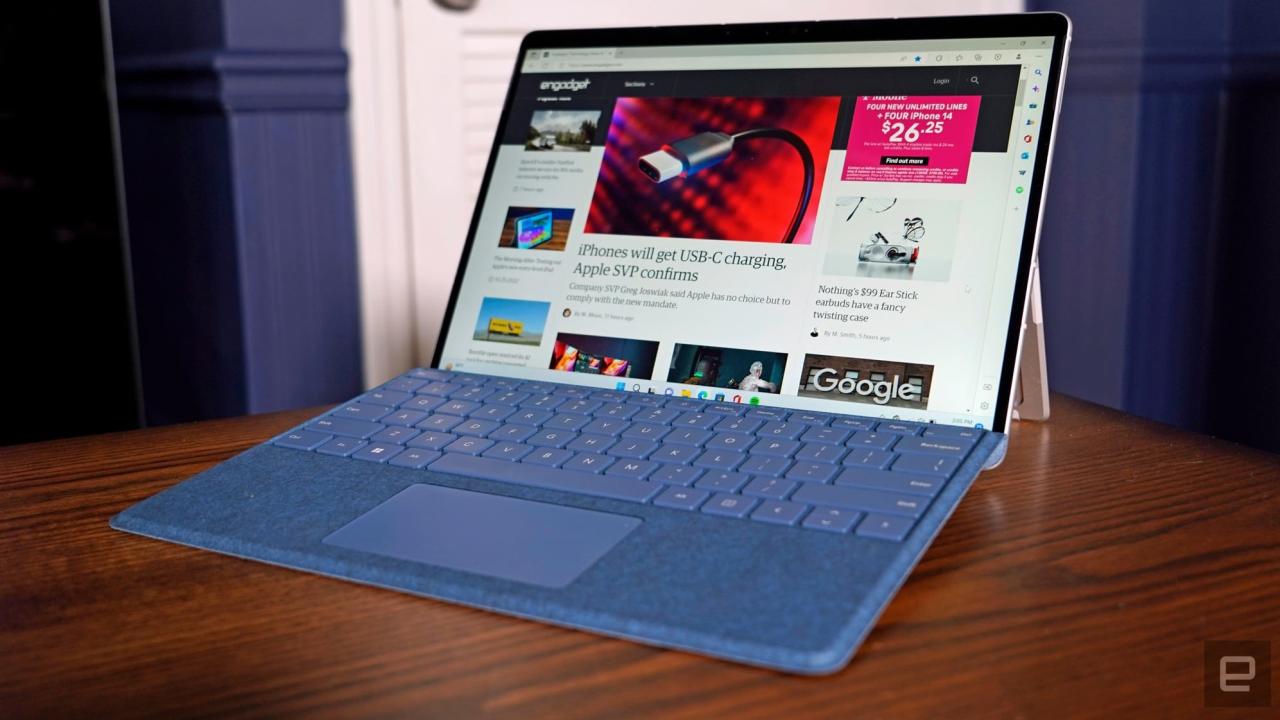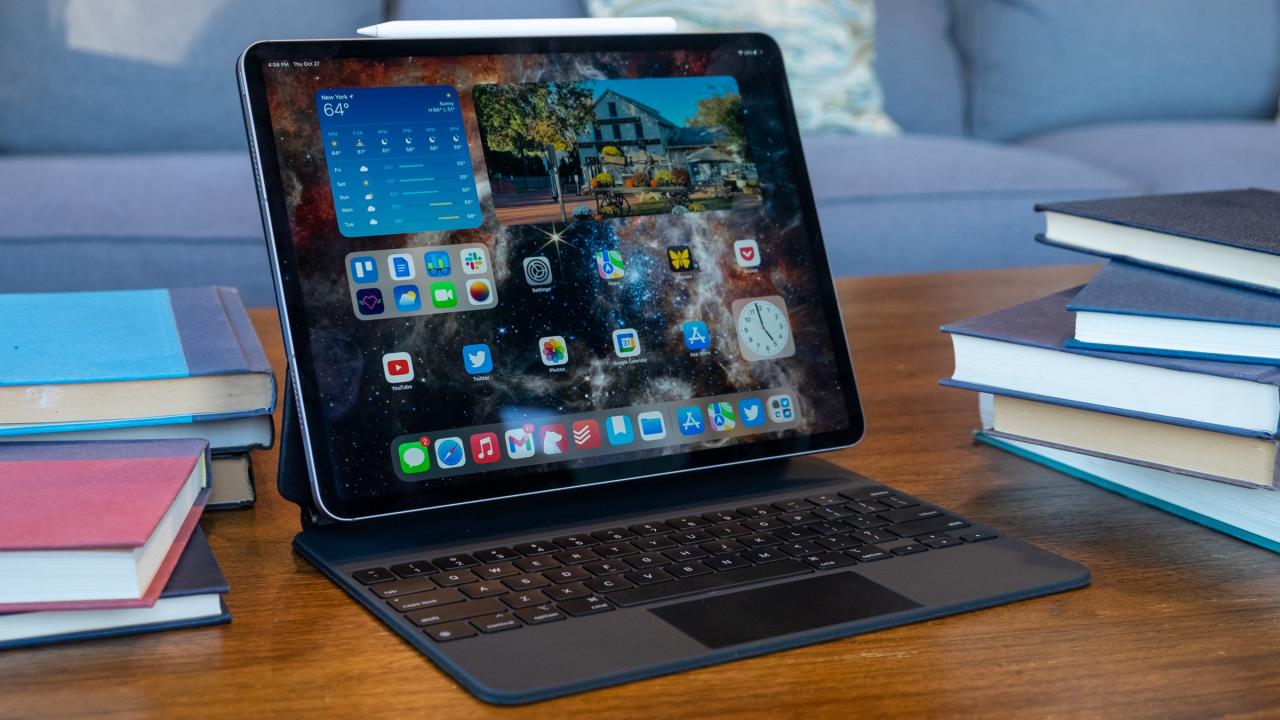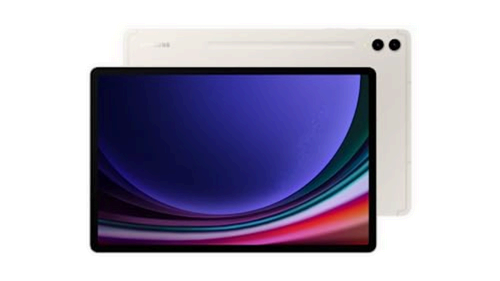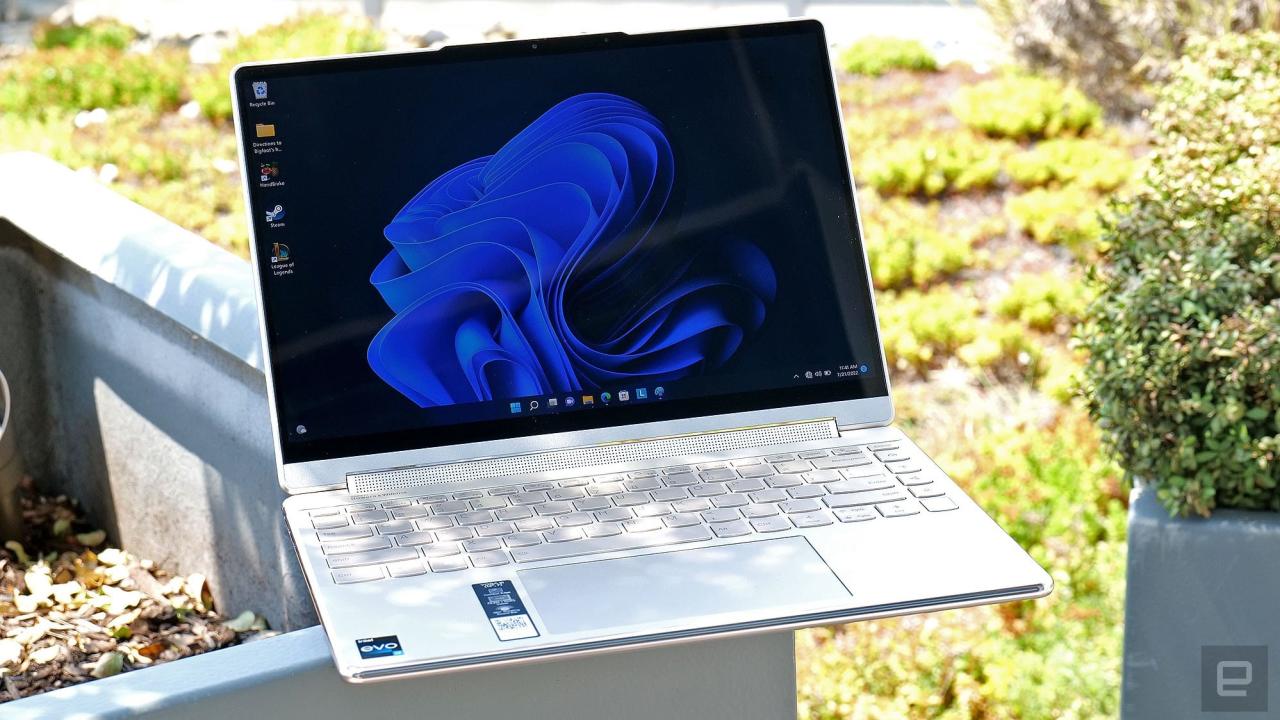We’re still waiting for the perfect hybrid PC that can work as well as a tablet as it does as a laptop. As we enter 2024, it seems like many companies have also given up on that ideal — but Microsoft, Apple and Samsung still have some options to consider. And we’re still seeing OS tweaks to make iOS and Android more usable for larger displays. If you’re on the hunt for your next computer and are dead-set on it being a 2-in-1, we’ve collected our current top picks here plus all of the things you should know before making a purchase.
Factors to consider before buying a 2-in-1 laptop
When you’re shopping for a 2-in-1, there are some basic criteria to keep in mind. First, look at the spec sheet to see how heavy the tablet is (alone, and with the keyboard). Most modern hybrids weigh less than 2 pounds, with the 1.94-pound Surface Pro 9 being one of the heaviest around. The iPad Pro 12.9 (2022) and Samsung’s Galaxy Tab S9+ are both slightly lighter. If the overall weight of the tablet and its keyboard come close to 3 pounds, you’ll be better off getting an ultraportable laptop.
You’ll also want to opt for an 11-inch or 12-inch screen instead of a smaller 10-inch model. Bigger displays will make multitasking easier, plus their companion keyboards will be much better spaced. Also, try to get at least 6GB of RAM if you can for better performance.
Finally, while some 2-in-1s offer built-in LTE or 5G connectivity, not everyone will want to pay the premium for it. An integrated cellular radio makes checking emails or replying to messages on the go far more convenient. But it also often costs more, and that’s not counting what you’ll pay for data. And, as for 5G — you can hold off on it unless you live within range of a mmWave beacon. Coverage is still spotty and existing nationwide networks use the slower sub-6 technology that’s barely faster than LTE. For now, tethering a PC to your phone is still the best way to get online.
These machines still have their limits, of course. Since they’re smaller than proper laptops, they tend to have less-powerful processors. Keyboards are often less sturdy, with condensed layouts and shallower travel. Plus, they’re almost always tablets first, leaving you to buy a keyboard case separately. (And those ain’t cheap!) So, you can’t always assume the advertised price is what you’ll actually spend on the 2-in-1 you want.
See Also:
Sometimes, getting a third-party keyboard might be just as good, and they’re often cheaper than first-party offerings. If you’re looking to save some money, Logitech’s Slim Folio is an affordable option, and if you don’t need your keyboard to attach to your tablet, Logitech’s K780 Multi-Device wireless keyboard is also a good pick.
While we’ve typically made sure to include a budget 2-in-1 in previous years, this time there isn’t a great choice. We would usually pick a Surface Go, but the latest model is still too expensive. Other alternatives, like cheaper Android tablets, are underpowered and don’t offer a great multitasking interface. If you want something around $500 that’s thin, lightweight and long-lasting, you’re better off this year looking at a conventional laptop (like those on our best budget PCs list).
Display: 13-inch PixelSense touchscreen | CPU: 12th-gen Intel Core i5/7 | Weight: 1.94 pounds | RAM: Up to 32GB | Storage: Up to 1TB
Read our full review of the Microsoft Surface Pro 9
There’s no beating the Surface series when it comes to 2-in-1s. They’re powerful, sleek tablets running an OS that’s actually designed for productivity. The Surface Pro 9 is Microsoft’s latest and great tablet, and it builds upon the already excellent Pro 8. It features speedy 12th-gen Intel CPUs and all of the major upgrades from last year, including a 120Hz display and a more modern design. It’s the best implementation of Microsoft’s tablet PC vision yet — though it may be worth waiting a few months for a CPU refresh.
Don’t confuse this model with the similarly named Surface Pro 9 with 5G, though, which has a slower ARM processor and inferior software compatibility. Built-in cellular is nice and all, but the Intel Pro 9 is a far better PC.
Like most of the other 2-in-1s on this list, the Pro 9 doesn’t come with a keyboard cover — you’ll have to pay extra for that. That’s a shame, considering it starts at $1,000. Microsoft offers a variety of Type Covers for its Surface Pros ranging from $100 to $180, depending on whether you want a slot for a stylus. But at least they’re comfortable and well-spaced. You can also get the Surface Slim Pen 2 ($130) for sketching out your diagrams or artwork, which features haptic feedback for a more responsive experience.
- Great AI webcam features
- Excellent hardware design
- Gorgeous 13-inch screen
- Convenient removable SSD
- Built-in 5G
- ARM chip leads to generally slow performance (Intel model is better)
- Still suffers from Surface ergonomic issues
Display: 12.9-inch Liquid Retina XDR touchscreen | CPU: Apple M2 | Weight: 1.5 pounds | RAM: Up to 16GB | Storage: Up to 2TB
Read our full review of the Apple iPad Pro
If you’re already in the Apple ecosystem, the best option for you is obviously an iPad. The 12-inch Pro is our pick. Like older models, this iPad Pro has a stunning 12.9-inch screen with a speedy 120Hz refresh rate, as well as mini-LED backlighting. While we’re still waiting for an update model with Apple’s new M3 chip, the existing M2 iPad Pro is still plenty powerful and offers excellent battery life.
Apple’s Magic Keyboard provides a satisfying typing experience, and its trackpad means you won’t have to reach for the screen to launch apps. But it’ll also cost you an extra $300, making it the most expensive case on this list by a lot. The iPad also lacks a headphone jack and its webcam is awkwardly positioned along the left bezel when you prop it up horizontally, so be aware that it’s still far from a perfect laptop replacement. Still, with its sleek design and respectable battery life, the iPad Pro 12.9 is a good 2-in-1 for Apple users.
- M2 chip is incredibly powerful
- Great battery life
- Screen and industrial design are still best-in-class
- Handy new Apple Pencil Hover feature
- Awkwardly placed front camera
- Stage Manager isn’t fully baked just yet
Display: 12.4-inch Dynamic AMOLED 2X touchscreen | CPU: Snapdragon 8 Gen 2 | Weight: 1.3 pounds | RAM: Up to 12GB | Storage: Up to 512GB
Read our full review of the Samsung Galaxy Tab S9 Ultra
While Windows is better than iPadOS and Android for productivity, it lags when it comes to apps specifically designed for touchscreens. If you want a tablet that has all the apps you want, and only need it to occasionally double as a laptop, the Galaxy Tab S9+ is a solid option. You’ll enjoy watching movies and playing games on its gorgeous 12.4-inch 120Hz AMOLED screen, and Samsung includes the S Pen, which is great for sketching and taking notes. The Snapdragon 8 Gen 2 chip and 12GB of RAM (4GB more than the last model) keep things running smoothly, too.
Samsung dramatically improved its keyboard case a few years ago for the S7+, making the Tab an even better laptop replacement. You could type for hours on this thing and not hate yourself (or Samsung). The battery life is also excellent, so you won’t need to worry about staying close to an outlet. The main caveat is that Android isn’t great as a desktop OS. And while Samsung’s DeX mode offers a somewhat workable solution, it has plenty of quirks.
- Beautiful screen
- Great speakers
- Powerful hardware
- S Pen is extremely responsive
- Dex mode is a surprisingly powerful multitasking interface
Display: 14-inch WQUXGA (3840 x 2400) OLED touchscreen | CPU: 13th-gen Intel Core i7 | Weight: 3.09 pounds | RAM: 16GB | Storage: Up to 1TB
Read our full review of the Lenovo Yoga 9i
Adaptability is the biggest strength of a 2-in-1, with devices like the Yoga 9i capable of transforming into a number of different modes at a moment’s notice. Even though it’s got a relatively portable 14-inch OLED display, Lenovo still found room on the Yoga 9i for three USB-C ports, a fingerprint scanner and a clever rotating soundbar to ensure audio sounds good in any position. Lenovo also includes a free stylus in the box but, unlike previous models, there isn’t a dedicated storage slot for it on the machine anymore. It’s also worth noting that, while its general design hasn’t changed much for 2023, Lenovo has improved the Yoga 9i’s performance with updated 13th-gen Intel processors.
- Gorgeous OLED display
- Powerful speakers
- Strong battery life
- Four USB-C ports
- Physical webcam shutter
- Included stylus and travel sleeve
- Whiny fans
- Shallow keyboard
- No built-in stylus storage





